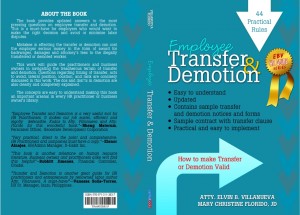A demotion is a reduction in position, rank or grade, or a movement to a lower type of position, which may or may not be accompanied by a reduction in salary, as a result of a transfer.
It is different from a reassignment or transfer which is a movement from one position to another which is of equivalent rank, level or salary, without interruption in service.
As a rule, changes in rank or position within the company are considered valid only when they are based on just and valid grounds such as genuine business necessity.
Even when a demotion is justified such as a reorganization to streamline operations, the employer must observe the proper procedure required of valid terminations. Part of due process in effecting a demotion is the presence of just cause. Without just cause, an unjustified demotion may constitute constructive dismissal, for which an employer may be held liable for backwages and damages.
What is constructive dismissal? How then should an employer go about transferring or demoting an employee in order to promote the goals of business?
These are just some of the things that the authors of “44 Rules of Employee Transfer and Demotion” answers in this practical guidebook.
The Labor Code hardly deals with transfers and demotions and you won’t find official set of rules to rely on to guide employers and employees alike. Instead, lawyers rely on Supreme Court rulings which deal with certain aspects of demotion. 44 Rules is a compilation of these rules which are embodied in numerous cases decided in the past few years.
If you don’t follow these basic rules, you could end up in a labor court defending a decision that may seem appropriate but which may lack certain legal requirements. Worse, you may be found liable for failing to meet these requirements and compelled to pay an employee not only backwages but also huge amounts as damages.
This guide will help you make informed decisions before it’s too late.
The authors (who are HR practitioners and lawyers at the same time) know how HR specialists and managers (even small business owners) struggle with documenting HR decisions. So, they’re doing their readers a favor—they have included sample notices and forms to guide you in laying down the basis of transfers and demotions the LEGAL WAY.
This is one guide you’ll want to keep as one of your tools for managing employees and your business!
Paperback copies of 44 Rules on Transfers and Demotions are now available at National Bookstore, Fully Booked and Powerbooks stores nationwide. If you are the type of person who wants to get hold of your copy now, an ebook version in PDF format is also available for purchase and delivery online. Get quick access to this guide with sample forms and notices in less than the time it will take you to head for the bookstore.
Grab your copy now!
